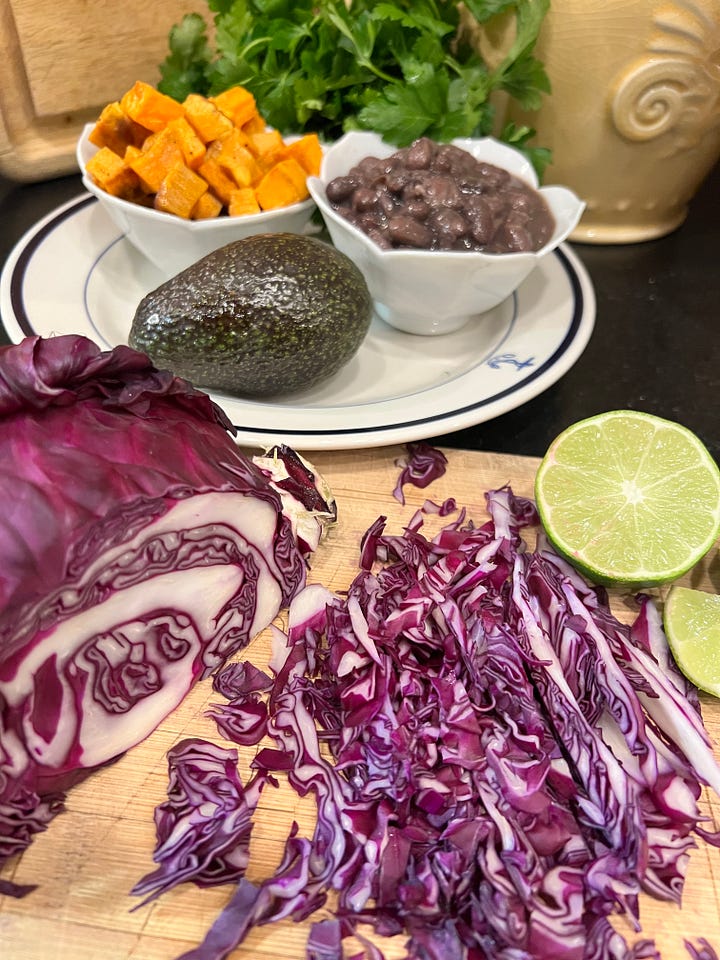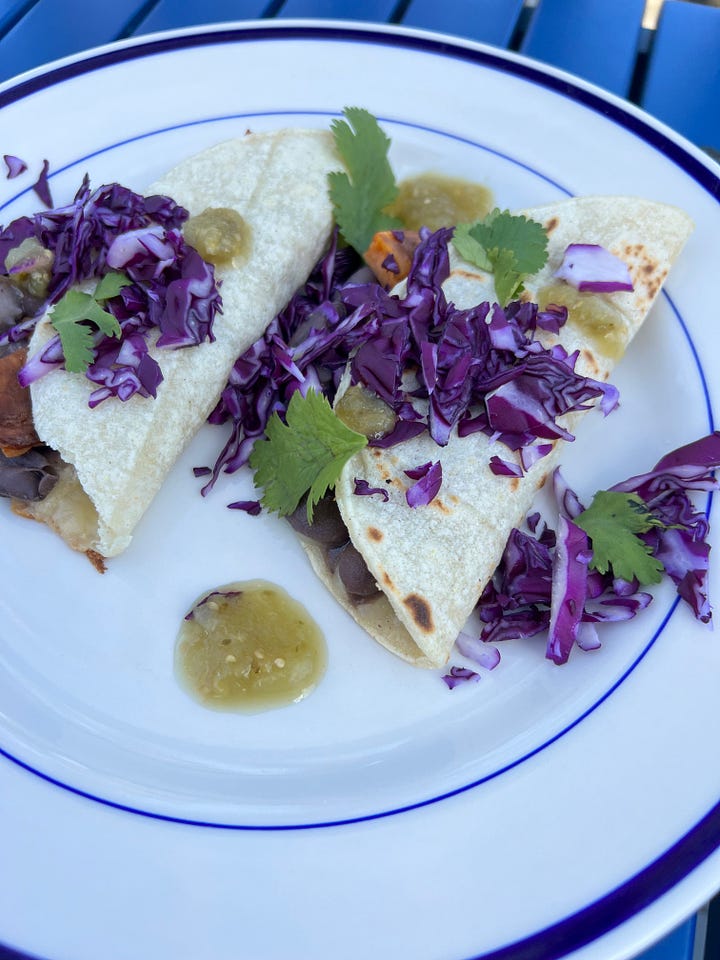Part 1–Setting the foundation
I was listening to Andrew Huberman’s “Huberman Lab” podcast on sugar and it made me sit up straight and lean in. I have always had a sweet tooth. That's the way I say it to make myself feel like it’s no big deal. Maybe when I was growing up in the 70’s it wasn’t as big a problem but since the early 2000s we have upped our sugar intake in the US by 25 fold. The reason I am reviewing and highlighting key points of this podcast is because I am not sure who needs to hear this information, I know I did. I spend time with recipes seeing how I can make them with less sugar. I use maple syrup but that still has high amounts of sugar (sucrose). I make quick breads with fruits for sweetness like bananas or blueberries or I make an apple cake. I have evolved as the information has but I love a yummy batch of chocolate chip cookies made the old fashioned way and I eat them up, too.
A quick point—There are many types of sugar mentioned in this podcast: fructose, high fructose corn syrup, sucrose, just to name a few. Think of them all as sugar and not good for our blood sugar regulation, insulin resistance and our metabolic health.
The podcast host, Andrew Huberman, PhD, is a neuroscientist and a tenured professor of neurobiology at Stanford School of Medicine. His guest, Robert Lustig, MD, neuroendocrinologist, professor of pediatrics at the University of California, San Francisco, honed in on fructose and how it affects our metabolic health. I recommend listening if the topic of sugar as it relates to your health interests you because I cannot possibly summarize the almost 3 hour podcast. I will try my best to share some key takeaways today and next week. A point Andrew Huberman definitely wanted to make clear is what he was taught, and what many still believe, is that a calorie is a calorie. If I consume more calories in whatever form than I metabolize then I will gain weight and the converse is true as well. Is a calorie truly a calorie when it comes to the processing of different calories?
Dr. Lustig agrees that people think obesity is about energy balance. That is, calories in, calories out. He agrees with the definition that a calorie is the unit of heat that raises 1 gram of water 1 degrees centigrade. A calorie burned is a calorie burned. No argument there. Where he delineates for Huberman and the listeners of the podcast is that, “A calorie eaten is not a calorie eaten.” and that is where the conversation begins.
Fiber
An example of a calorie eaten is not a calorie eaten: almonds. If you eat 160 calories of almonds how many calories do you absorb? 130. Where did the other 30 go? The fiber in the almonds, both soluble and insoluble (Fiber is the key here) forms a gel on the inside of our intestines; the insoluble fiber (cellulose) forms a fishnet, a lattice work, on the inside of our duodenum, the soluble fiber, which are globular plug the holes in the fishnet. Together they form a secondary barrier, a whitish gel and that prevents absorption of those 30 calories. (This is similar to when I wrote about the soluble and insoluble fiber in beans that I learned from Karen Hurd). These 30 calories travel further down the intestine to the next part called the jejunum where the microbiome is. We all know or are hearing so much more about the microbiome today. The bacteria in the microbiome must eat. They eat what we eat. When we eat almonds we feed our gut and that is a good thing. Our gut takes those calories and turns it into short chain fatty acids (SCFA) which are protective against chronic metabolic disease. SCFAs such as acetate, propionate, butyrate, valerate are good; they are anti-inflammatory, anti-alzheimer’s because we feed our microbiome. A calorie eaten is not a calorie eaten because if it includes fiber it was not for us, it was for our bacteria.
Amino Acids
He quickly talks about amino acids. There is a detailed medical explanation that you will hear if you listen to the podcast which I will not try to explain here because I am concentrating on sugar today not proteins. He further sums up that 10% of everything we eat calorie-wise goes to maintaining body temperature called the thermic effect of food.
Fats
Omega 3s-heart healthy, antiinflammatory, antialzheimers, save your life. Omega 3s don’t get broken down for energy because they are so important they stay intact because our brain needs them, our heart needs them.
Transfats-Dr. Lustig calls them “the devil incarnate”, consumable poison because we cannot break the trans double bond; we don’t have what is needed in our body to break the double bond. It accumulates, lines your arteries, lines your liver and causes metabolic disease, causes insulin resistance.
One of these fats can save our life and the other kill us. Both are 9 calories/gram if we are looking at a calorie burned. However a calorie eaten is not a calorie eaten because one saves our life and one kills us. Yikes.
Fructose and glucose.
Glucose is the energy of life. Every cell on the planet burns glucose for energy. Glucose is so important if we don’t consume it our body will make it. It will take an amino acid and turn it into glucose. That process is called gluconeogenesis. It will also take a fatty acid and turn it into glucose (the glycerol portion of the triglyceride will turn into glucose) Dr. Lustig continues with much more detail of how important glucose is and what happens as we age.
Fructose like that in high fructose corn syrup is a sweetener added to processed foods and drinks. 73% of all items in the grocery store have added sugar on purpose; the food industry’s purpose not for our purpose, because fructose is addictive. It activates the reward center of the brain in the same way that cocaine, heroine, nicotine and alcohol do and drive dopamine receptors down just like nicotine, alcohol, cocaine and heroine do. That molecule, fructose, is completely vestigial to all vertebrate life. There is no chemical reaction in any vertebrate that requires dietary fructose.
All of that to say, fructose has no function in the human body.
Quick commercial break for anyone’s mind jumping ahead and thinking about their consumption of berries like Andrew Huberman did. Here is what the Dr. Lustig said,
Berries? No problem. Fruit is ok because of the fiber. The molecule is the same whether it’s a berry, a banana or a can of coca cola. However, when it is a berry it comes with alot of fiber, a banana, less fiber and with coke, it doesn’t come with any fiber. The fiber is what mitigates the absorption. When you consume fructose with fiber, the berries, we are feeding our microbiome, that fructose was not for us.
He highlighted, again, fructose itself, if it is not partnered with fiber is not required for survival and it is problematic.
What fructose does:
Fructose inhibits three separate enzymes for normal mitochondrial function. The National Institute of Health explains,
The classic role of mitochondria is oxidative phosphorylation, which generates adenosine triphosphate (ATP) by utilizing the energy released during the oxidation of the food we eat. ATP is used in turn as the primary energy source for most biochemical and physiological processes, such as growth, movement and homeostasis. We turn over approximately our own body weight in ATP each day, and almost all of this is generated by mitochondria, primarily within muscle, brain, liver, heart and gastrointestinal tract.5 The pre-eminent role of eating is to provide the fuel for mitochondria, and the pre-eminent role of breathing is to provide the oxygen and to remove the carbon dioxide produced during oxidative phosphorylation by mitochondria. Similarly, a major role of the cardiovascular system is to deliver the substrates (glucose, fatty acids, oxygen) and remove the products (carbon dioxide) of mitochondrial activity.
Our mitochondria must work at peak efficiency. That is what metabolic health is. Is mitochondria working at peak efficiency?
How bad is it really?
Humberman, our podcast host, inquires about the degree to which fructose is harmful to us. Because there are many drugs that block bodily functions so what exactly are we talking about.
To which the doctor and he discuss the following:
Three levels of toxins
Toxins with parts per billion that will kill us like serine, cyanide
Intermediate toxins like arsenic (take a little longer to work, don’t kill you on the spot)
Weak toxins: Fructose is in this category.
They end this discussion with, its not what you do one day, it's what you do every day.
Ultimately you will lose years on your life. He has the data that proves this.
Sugar tax
We pay an 8 year longevity tax just by living in the US. Our mean age is 80 versus Japan’s mean age of 88 years. That is for healthy people. If you have obesity it’s a 15 year longevity tax, if you have metabolic syndrome its a 20 year longevity tax. It’s primarily caused from sugar. With help from transfats, which are now illegal. They are gone from ultra processed foods. But the sugar is not.
Sugar is now the big problem because of the three enzymes they inhibit which does not allow the body to work at its peak.
They started the podcast with the question, is a calorie a calorie, but if it inhibits mitochondrial function a calorie is not a calorie.
Andrew Huberman boils it down that if we are eating sugar and the sugar is inhibiting our mitochondrial function then we are reducing the intensity of the furnace within our body. The doctor says the hypothesis, a calorie is a calorie makes no sense. There is no study to support this statement.
The good news is if you are reading this blog you are most likely curious, as am I, on how to include ways to eat nourishing food. The podcast and this blog post is not about judgment on what we eat but rather to provide information to help with decisions on what we put in our bodies over the course of a week, a month, or a year. Dr. Lustig fully believes in having dessert. He does not suggest eating dessert at breakfast, lunch and dinner but having a dessert will not affect us when we do it in conjunction with healthy eating practices. Never once did he say we must ban sugar. He did repeat a few times that unlike glucose, the human body does not need fructose. As we will read next week, he would like the food industry and the people who are overseeing said industry to be responsible partners.
Stay tuned. I will write next week on how the food industry supports consumer confusion. And you will be armed with information to make your own decisions.
Until then, Start with Beans!
Recommended Recipe
Sweet potato, bean and red cabbage tacos
Delicious after making a pot of beans or easy enough to have midweek if using canned beans. The sweet potato was prepped ahead of time. Makes enough for 4-6 tacos, easily doubled.
Ingredients
1 large sweet potato~ 1 lb, peeled, chopped into 1/2 inch cubes
1 Tsp olive oil
1 cup of beans (I had made a pot of Rio Zape beans from Rancho Gordo, they are plump with a hint of chocolate. Pinto, black bean or kidney would also be delicious)
1/4 head of small red cabbage, sliced thin or you can use a mandolin
4-6 corn tortillas
green tomatillo salsa (jar or tin)
Cilantro
lime for serving
feta or other cheese optional


Preheat your oven to 400, take your diced sweet potato in a bowl and add the olive oil with salt and pepper. Pour onto a sheet pan lined with parchment or a bit more olive oil and roast your sweet potatoes for 20 minutes. Flip halfway through and turn the sheet pan around. After the 20 minutes test with a fork. The fork should easily pierce the potatoes and hold it shape but be soft enough to smoosh them into a taco. Your preference will determine if they need another 5 minutes or if they are finished. The sides will be browned from roasting.
Meanwhile open your can of beans, rinse and heat them with a little veggie stock, garlic powder, cumin, salt and pepper to taste. If you made a pot of beans you will use about 1-2 Tsp per taco.
Contact
If you have any questions on integrating beans consistently for gut health now and into the near future, please email me at Denisemancieri1@gmail.com. Feel free to comment below if there are topics you would like to see.
Please share this newsletter with others if you find it may assist them in adding beans to their diet. Or click the heart, below left, so I know you were here. Thank you!
Note: I am not a doctor. I am a teacher and an educator with an earned doctorate in educational leadership. I enjoy research and I can distill large amounts of information into easily understood and digestible pieces allowing people to understand what is happening to their body and possible steps to reverse it with food as medicine. I have healed my own GI issues through choices with food. I followed Karen Hurd’s bean protocol diet, I meditated and still do and I healed. I feel compelled to be in service and educate others as the more people eating beans, alongside a healthy diet and sharing their stories the more people will live a healthier existence. Joy, peace and freedom abound. Please see your doctor and discuss nutritional options before you change any course of action with your health.





